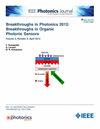用于循环癌症外泌体无标记检测的50THz超宽带纳米光子学完美吸收生物传感器:推进早期癌症诊断
IF 2.4
4区 工程技术
Q3 ENGINEERING, ELECTRICAL & ELECTRONIC
引用次数: 0
摘要
本文讨论了利用微波成像(MWI)技术对循环外泌体进行早期癌症诊断的挑战,最近发现循环外泌体是有前途的癌症生物标志物。我们介绍了一种创新的纳米光子完美吸收器(NPA),工作在太赫兹(THz)范围内,在简单性、灵敏度和特异性方面比现有的基于mwi的方法有了重大改进。与以前的太赫兹吸收器不同,该NPA实现了从100 GHz到50太赫兹的异常宽的工作带宽,吸收效率超过97.5%,同时具有超紧凑的纳米尺寸(100 × 100 nm2,厚度30 nm)。该设计将银(Ag)谐振器和镍(Ni)地平面集成在二氧化硅(SiO2)衬底上,精心调整几何形状以创建多个谐振模式,实现连续宽带吸收。全波电磁仿真验证了该结构的性能,包括电场和磁场分布、表面电流和散射参数。与最先进的吸收器的比较分析表明,我们的设备具有优越的带宽,吸收稳定性和角度鲁棒性。此外,我们证明了NPA作为外泌体检测的无标记生物传感器的独特能力,其中癌外泌体由于其独特的分子组成而始终诱导比正常外泌体更强的电场响应。这些结果证实了NPA是通过MWI进行非侵入性早期癌症诊断的一种新颖、高效的平台。本文章由计算机程序翻译,如有差异,请以英文原文为准。
A 50THz Ultra-Wideband Nano-Photonics Perfect Absorber Biosensor for Label-Free Detection of Circulating Cancer Exosomes: Advancing Early Cancer Diagnostics
This paper addresses the challenge of early-stage cancer diagnosis using microwave imaging (MWI) techniques by targeting circulating exosomes, recently identified as promising cancer biomarkers. We introduce an innovative nano-photonic perfect absorber (NPA) operating in the terahertz (THz) range, offering a significant improvement over existing MWI-based approaches in terms of simplicity, sensitivity, and specificity. Unlike previous THz absorbers, the proposed NPA achieves an exceptionally wide operating bandwidth from 100 GHz to 50 THz with an absorption efficiency exceeding 97.5%, while featuring an ultra-compact nanoscale footprint (100 × 100 nm2, thickness 30 nm). The design integrates a silver (Ag) resonator and a nickel (Ni) ground plane on a silicon dioxide (SiO2) substrate, with meticulously tuned geometries to create multiple resonance modes, enabling continuous broadband absorption. Full-wave electromagnetic simulations validate the structure’s performance, including electric and magnetic field distributions, surface currents, and scattering parameters. Comparative analysis with state-of-the-art absorbers demonstrates the superior bandwidth, absorption stability, and angular robustness of our device. Furthermore, we demonstrate the NPA’s unique ability to act as a label-free biosensor for exosome detection, where cancerous exosomes consistently induce stronger electric field responses than normal exosomes due to their distinct molecular compositions. These results confirm the proposed NPA as a novel, highly effective platform for non-invasive, early-stage cancer diagnostics via MWI.
求助全文
通过发布文献求助,成功后即可免费获取论文全文。
去求助
来源期刊

IEEE Photonics Journal
ENGINEERING, ELECTRICAL & ELECTRONIC-OPTICS
CiteScore
4.50
自引率
8.30%
发文量
489
审稿时长
1.4 months
期刊介绍:
Breakthroughs in the generation of light and in its control and utilization have given rise to the field of Photonics, a rapidly expanding area of science and technology with major technological and economic impact. Photonics integrates quantum electronics and optics to accelerate progress in the generation of novel photon sources and in their utilization in emerging applications at the micro and nano scales spanning from the far-infrared/THz to the x-ray region of the electromagnetic spectrum. IEEE Photonics Journal is an online-only journal dedicated to the rapid disclosure of top-quality peer-reviewed research at the forefront of all areas of photonics. Contributions addressing issues ranging from fundamental understanding to emerging technologies and applications are within the scope of the Journal. The Journal includes topics in: Photon sources from far infrared to X-rays, Photonics materials and engineered photonic structures, Integrated optics and optoelectronic, Ultrafast, attosecond, high field and short wavelength photonics, Biophotonics, including DNA photonics, Nanophotonics, Magnetophotonics, Fundamentals of light propagation and interaction; nonlinear effects, Optical data storage, Fiber optics and optical communications devices, systems, and technologies, Micro Opto Electro Mechanical Systems (MOEMS), Microwave photonics, Optical Sensors.
 求助内容:
求助内容: 应助结果提醒方式:
应助结果提醒方式:


